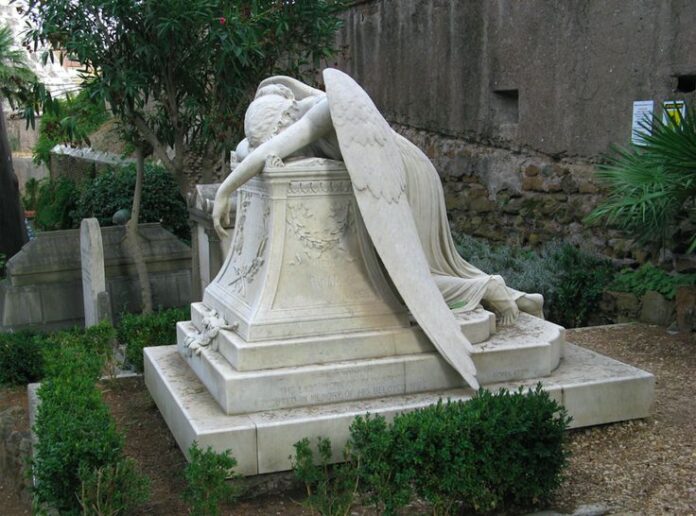At the demise of a loved one what else can we, the beloved, do other than fall over the dismantled altar of life and weep? They transform themselves into angels of grief. Is there anyone who hasn’t become a ‘weeping angel’ at least once in a lifetime?
It happened a few years back, to be precise, in March 2009. I was living in the eternal city of Rome, doing my studies. Rome is one of the most important tourist destinations of the world, owing to the incalculable immensity of its archaeological and artistic treasures, as well as due to the charm of its unique traditions, the beauty of its panoramic views, and the majesty of its magnificent ‘villas.’
One day, my friend Fr. Sabu Mannada, writer and artist, came to Rome with the intention of visiting the major attractions of the city. As we are close friends, I accompanied him during his visit. After our visit to the Colosseum, Maria Maggiore, Pantheon, Fontana di Trevi etc., we went to see the Pyramid of Cestius which is another attraction in Rome. The pyramid was built most likely between 18 and 12 BC. It is located on the way to the Basilica of St. Paul, and there is a Protestant Cemetery, also known as ‘Englishmen’s Cemetery,’ close to this pyramid.
As soon as we got there, it started drizzling. Hence, we thought of continuing our walk alongside the cemetery wall. The tall wall had several small and big cracks which gave some view to the tombs on the other side of the wall. It was, indeed, unpleasant to walk in the bad weather. Gradually we were losing our interest. I peeped through the cracks just to divert my attention from the annoyance of walking in the rain. My eyes stuck on an epitaph on a tombstone. I felt it was very familiar to me. Yes, it was true! ‘Here lies one whose name was writ in water!’
I remembered that it was the epitaph engraved on the tombstone of the English Romantic poet John Keats. How come the tomb of an English poet here in Italy? I wanted to have a closer look at the tomb and the epitaph. Unfortunately, the cemetery was locked, being a holiday. On the way back, my mind was occupied with Keats, his tomb, and the poems I learned during my college days.
In the evening I was back in the Hostel run by the Oblates of Virgin Mary (Oblati di Maria Vergine) on the Via Casilina. It was my residence during my five years of doctoral studies in Rome. As soon as I entered my room, I started searching for John Keats on Google. I started reading about him.
John Keats was the last of the Romantic poets and the one who died very young! He spent his final months in Rome. I wanted to know more about him. With an increased interest and enthusiasm, I carried on my reading and search.
On his arrival in Italy, Keats moved into a villa on the Spanish Steps in Rome. It has become the Keats–Shelley Memorial House museum today. Keats displayed increasingly serious symptoms of tuberculosis. Regardless of the care from Severn and Dr. James Clark, his health deteriorated rapidly. The first months of 1821 marked a slow and steady decline into the final stage of tuberculosis. Keats was coughing up blood and immersed in sweat. Severn who nursed him devotedly, writes:
“Keats was completely trembling. I knew that he was dying. He said, ‘Severn, lift me up. I am dying. I shall die easy. Don’t be frightened; be firm, and thank God it has come.’ I lifted him up in my arms and he gradually sank into death, so quiet, that I still thought he slept. It was on 23rd of February 1821. John Keats died in Rome at the age of 25!”
He died in Rome; therefore the funeral must also have been there. I continued reading. “His body was buried in the city’s Protestant Cemetery. The tombstone had the epitaph: This Grave contains all that was mortal of a young English Poet who on his death bed, in the bitterness of his heart at the malicious power of his enemies desired these words to be engraved on his tombstone: Here lies One Whose Name was writ in Water. 24 February 1821. Clark, his friend, saw to the planting of daisies on the grave, saying that Keats would have wished it. “In the old part of the graveyard, barely a field when Keats was buried here, there are now umbrella pines, myrtle shrubs, roses, and carpets of wild violets.”
Yes, what I saw was indeed the tomb of John Keats! “Heard melodies are sweet, but those unheard, are sweeter,” wrote Keats! It was also the cemetery of P.B. Shelley, the great author of classic poems such as Ozymandias, Ode to the West Wind, To a Skylark etc.
I found out the opening timing of the cemetery from the website. The next day, I reached there much earlier. First I went to the tomb of John Keats. I read repeatedly the epitaph: Here lies one whose name is writ in the water.
Then I went to the tomb of Shelley and spent some time there too. I looked around. A huge cemetery with tombs everywhere! Not a single living being there! All of them were people whose names were written in water. Washed away even before the writing was complete! The water on which the writing was tried also might have flowed off or dried up!
There has been also the statue of the Angel of Grief or the Weeping Angel in this cemetery. It is a sculpture by William Wetmore Story, from 1894, for the grave of his wife Emmelyn Story. The complete title bestowed for this statue was The Angel of Grief Weeping Over the Dismantled Altar of Life.
What else can one do at the demise of a loved one, other than weeping over the altar of one’s life? One becomes the angel of grief. Is there anyone who has not become a weeping angel at least once in his or her life?
Some say that death is the only unchanging reality. In a way it is partially true. Everything changes. Trees, flowers, mountains, snow humans and animals, everyone undergo changes. Death alone is certain for everyone. All of them become names written in water. Let us also remember that the world and its desires pass away (I Jn. 2, 17).
However, as I stand at the tomb of my beloved father at the cemetery of Mar Sleeva Church, Malayinchipara, and at the tomb of my much-loved sister at the cemetery of Lalam old church, Palai, I am reminded not of the people whose names are written in water, rather of the people whose names have been firmly written in hearts, in the hearts of their beloved people. While visiting those tombs, everyone, including me, became weeping angels.
Have we not wept over the memories of our dear departed ones at least once in our lifetime? Weeping Angel could be a state of life which we have already grown into or a state of life yet to grow into.
Written by: Fr. G. Kadooparayil MCBS
Translated by: Fr. Jaimon Mulappancheril MCBS



